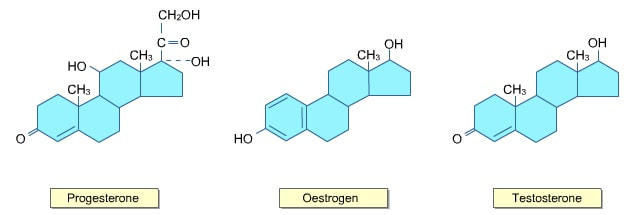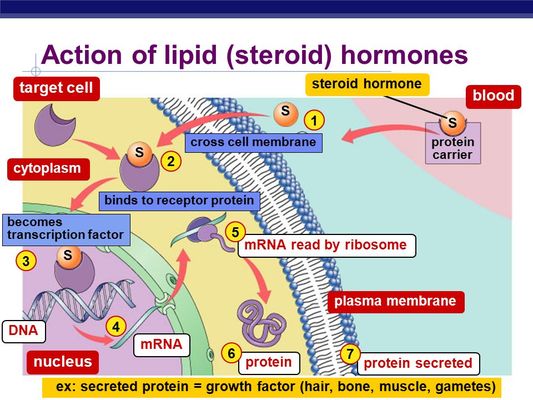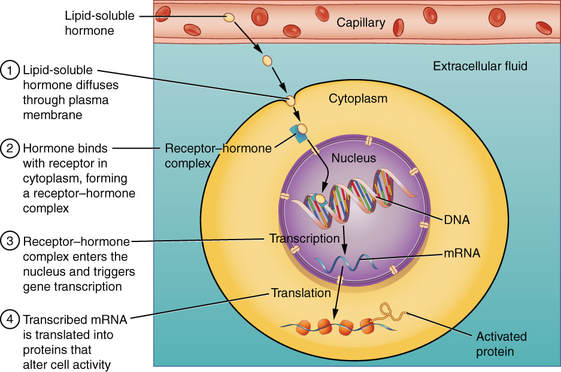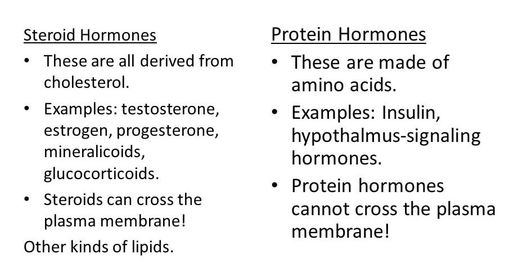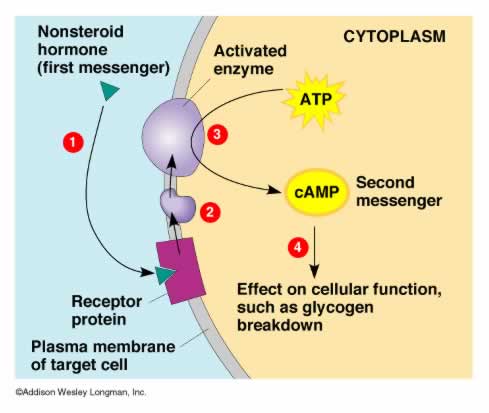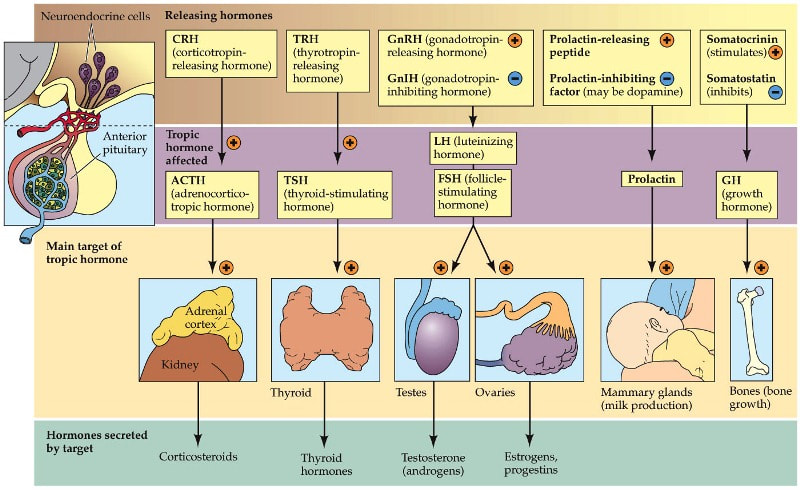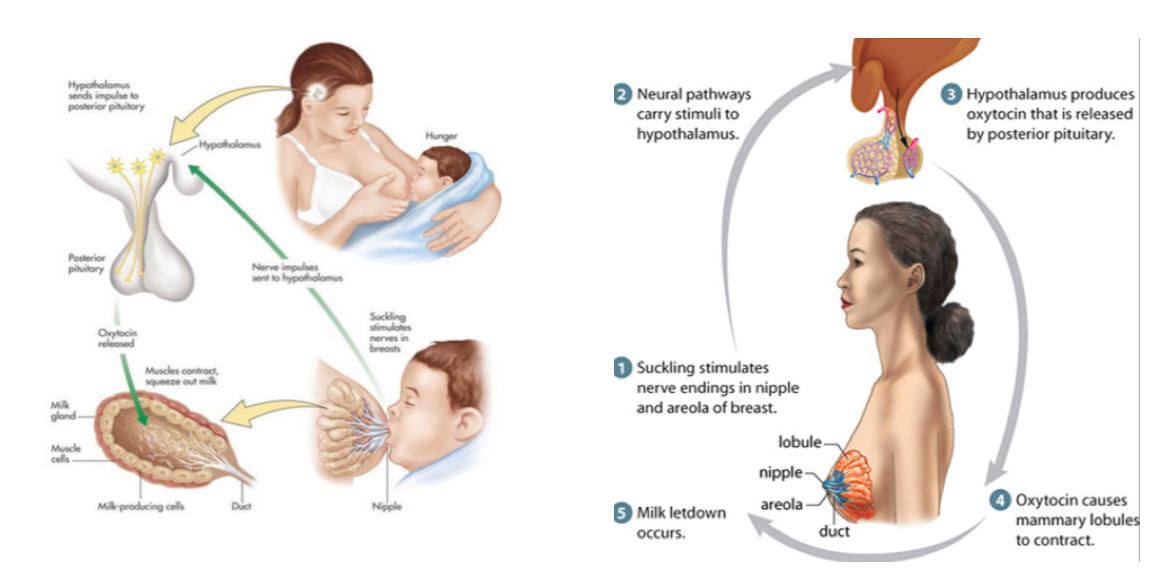D.5: hormones and metabolism (HL)
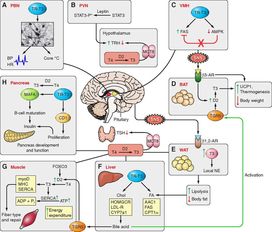 image from Physiological Reviews
image from Physiological Reviews
In the Hormones and Metabolism unit we will learn
This unit will last 5 school days
This unit will last 5 school days
Essential idea:
- Hormones are not secreted at a uniform rate and exert their effect at low concentrations.
Nature of science:
- Cooperation and collaboration between groups of scientists—the International Council for the Control of Iodine Deficiency Disorders includes a number of scientists who work to eliminate the harm done by iodine deficiency. (4.3)
Understandings
D.5 U 1 Endocrine glands secrete hormones directly into the bloodstream.
- State the function of endocrine glands.
- State the function of hormones.
The endocrine system uses chemical signals to communicate and regulate the body’s physiology. The system releases hormones that act on target cells to regulate development, growth, energy metabolism, reproduction, and many behaviors. Endocrine glands contain no ducts; they release their secretions directly into the intercellular fluid or into the blood. The collection of these glands makes up the endocrine system. The main endocrine glands, which we will learn about in this section and in the following ones, are the pituitary (anterior and posterior), thyroid, parathyroid, adrenal (cortex and medulla), pancreas, and gonads.
D.5 U 2 Steroid hormones bind to receptor proteins in the cytoplasm of the target cell to form a receptor–hormone complex.
- Describe the mechanism of steroid hormone action.
- List two example steroid hormones.
Steroid hormones are made from cholesterol and have a characteristic pattern of carbon based rings that you need to be able to recognize - NOT draw. They are hydrophobic and so can cross membranes.(Note that the plasma protein, albumin, transports steroid hormones in blood plasma). These include the plasma membrane and the nuclear membrane. Once inside the cell it binds to a receptor in the cytoplasm and the complex (of hormone and receptor) crosses the nuclear membrane. The hormone receptor complex directly influences the transcription of genes as it binds to a region in front of the gene called a promoter region. This can promote or inhibit the transcription of the DNA and hence production of the gene product . The hormone receptor complex acts as a transcription factor regulating gene expression. Examples include Testosterone, Oestrogen, Progesterone.
D.5 U 3 The receptor–hormone complex promotes the transcription of specific genes
Steroid hormones cause changes within a cell by first passing through the cell membrane of the target cell. Steroid hormones, unlike non-steroid hormones, can do this because they are fat-soluble. Cell membranes are composed of a phospholipid bilayer which prevents fat-insoluble molecules from diffusing into the cell.
Once inside the cell the steroid hormone binds with a specific receptor found only in the cytoplasm of the target cell. The receptor bound steroid hormone then travels into the nucleus and binds to another specific receptor on the chromatin. Once bound to the chromatin, this steroid hormone-receptor complex calls for the production of specific RNA molecules called messenger RNA (mRNA) by a process called transcription. The mRNA molecules are then modified and transported to the cytoplasm. The mRNA molecules code for the production of proteins through a process called translation.
Once inside the cell the steroid hormone binds with a specific receptor found only in the cytoplasm of the target cell. The receptor bound steroid hormone then travels into the nucleus and binds to another specific receptor on the chromatin. Once bound to the chromatin, this steroid hormone-receptor complex calls for the production of specific RNA molecules called messenger RNA (mRNA) by a process called transcription. The mRNA molecules are then modified and transported to the cytoplasm. The mRNA molecules code for the production of proteins through a process called translation.
D.5 U 4 Peptide hormones bind to receptors in the plasma membrane of the target cell.
Protein hormones cannot pass through membrane (amino acid and water based). Instead the bind to receptors on the plasma membrane called the G-coupled receptor
Examples of protein hormones:
- GTP is used to activate adenylyl cyclase
- Adenylyl cyclase converts ATP into cAMP (secondary messenger)
- Secondary messengers are small, water soluble molecules that spread throughout the cytoplasm, relaying a signal
- cAMP activates protein kinase enzymes which activates or inhibits enzymes
Examples of protein hormones:
- Insulin
- ADH (vasopressin)
- FSH/LH
- HCG
- Oxytocin
- Glucagon
- Epinephrine
D.5 U 5 Binding of hormones to membrane receptors activates a cascade mediated by a second messenger inside the cell.
Second messengers are molecules that relay signals received at receptors on the cell surface — such as the arrival of protein hormones, growth factors, etc. — to target molecules in the cytosol and/or nucleus. But in addition to their job as relay molecules, second messengers serve to greatly amplify the strength of the signal. Binding of a ligand to a single receptor at the cell surface may end up causing massive changes in the biochemical activities within the cell.
There are 3 major classes of second messengers:
There are 3 major classes of second messengers:
- cyclic nucleotides (e.g., cAMP and cGMP)
- inositol trisphosphate (IP3) and diacylglycerol (DAG)
- calcium ions (Ca2+)
D.5 U 6 The hypothalamus controls hormone secretion by the anterior and posterior lobes of the pituitary gland.
Hypothalamus links nervous system to endocrine system – it controls the pituitary. Pituitary secretes hormones
- Hypothalamus secretes releasing factors
- Stimulate the secretion of anterior pituitary gland’s hormones
- Negative feedback is involved in control of secretion of many of the pituitary hormones
- ADH can be used as an example:
- Blood solute concentration monitored by osmoreceptors in hypothalamus
- Detect solute concentration too high – impulses are sent along axons of neurosecretory cells causing ADH to increase
- ADH acts on kidney and causes blood solute to increase
- Solute too low, osmoreceptors detect it and fewer or no impulses are sent – ADH secretion reduces or stops
- ADH can be used as an example:
- Hypothalamus contains neurosecretory cells that produce hormones (ADH and oxytocin)
- Connected to the posterior pituitary through infundibulum
- Hormones travel axons of neurosecretory cells to be stored in terminal branches
- ADH and oxytocin released into capillary network from posterior pituitary when neurons fire
D.5 U 7 Hormones secreted by the pituitary control growth, developmental changes, reproduction and homeostasis.
Anterior pituitary synthesizes and secretes a number of hormones that control growth, reproduction, and homeostasis
- FSH and LH
- Oxytocin – reproduction/developmental changes
- FSH and LH – reproduction
- TSH – homeostasis
- Prolactin – developmental changes
- GH – growth
Application
D.5 A 1 Some athletes take growth hormones to build muscles.
Growth hormone is a peptide hormone produced by cells in the anterior pituitary. The Growth hormone is often taken by athletes in an bid to gain a competitive advantage over their competitors.
These include - don't remember all of these, the main one is muscle mass
Growth Hormone promotes:
These include - don't remember all of these, the main one is muscle mass
Growth Hormone promotes:
- synthesis of proteins - remember muscle cells have a large amount of protein
- breakdown of fat
- increased number of cartilage cells - important component of joints/tendons
- increased mineralisation and strength of bones
- increased muscle mass
- increased organ growth e.g muscle mass in the heart (except the brain).
D.5 A 2 Control of milk secretion by oxytocin and prolactin.
Prolactin stimulates the mammary glands to grow and produce milk.
During pregnancy high levels of progesterone and estrogen stimulate prolactin production. Breat development takes place but inhibit its effects in terms of milk production.
Estrogen and progesterone decline rapidly after birth (placenta has been expelled) and so milk production increases.
The milk is stored in small sacs called alveoli.
Suckling of the baby, smell and sight of the baby stimulates oxytocin secretion from the posterior pituitary. Oxytocin causes the release of the milk from these alveoli and so can be accessed by the baby.
During pregnancy high levels of progesterone and estrogen stimulate prolactin production. Breat development takes place but inhibit its effects in terms of milk production.
Estrogen and progesterone decline rapidly after birth (placenta has been expelled) and so milk production increases.
The milk is stored in small sacs called alveoli.
Suckling of the baby, smell and sight of the baby stimulates oxytocin secretion from the posterior pituitary. Oxytocin causes the release of the milk from these alveoli and so can be accessed by the baby.
Key Terms
|
hormone
steroid hormone action second messenger system posterior lobe ADH prolactin peptide hormone cascade reaction G-protein supraoptic nucleus |
endocrine gland
transcription hypothalamus neurosecretory cells growth hormone iodine deficiency lipid hormone hydrophilic FSH paraventicular nucleus |
steroid
protein hormone pituitary gland metabolism target cell ICCIDD estrogen calcium ion LH infundibulum |
receptor proteins
epinephrine anterior lobe negative feedback oxytocin chemical messenger goiter cyclic AMP oxytocin insulin |
Correct use of terminology is a key skill in Biology. It is essential to use key terms correctly when communicating your understanding, particularly in assessments. Use the quizlet flashcards or other tools such as learn, scatter, space race, speller and test to help you master the vocabulary.
Useful Links
Performance-enhancing drugs: Know the risks
Performance-enhancing and banned drugs explained
In The News
Performance-enhancing drugs: Know the risks
Performance-enhancing and banned drugs explained
In The News
Video Clips
The hypothalamus and pituitary gland. I discuss the two major roles of the hypothalamus: homeostasis and hormones. I also explain how the hypothalamus controls hormone release by manipulating the pituitary gland. I cover the anterior and posterior lobes of the pituitary gland, along with the most common hormones secreted from each lobe.
Hank begins teaching you about your endocrine system by explaining how it uses glands to produce hormones. These hormones are either amino-acid based and water soluble, or steroidal and lipid-soluble, and may target many types of cells or just turn on specific ones.
The Olympics are upon us, and unfortunately, many athletes use performance enhancing drugs to boost their ability. What exactly does doping and steroids do to your body?
Watch the second video in our Breastfeeding Educational Series to answer the question, how will my breast know how much milk to make? Four hormones stimulate milk production and work together to produce breast milk for your baby.

